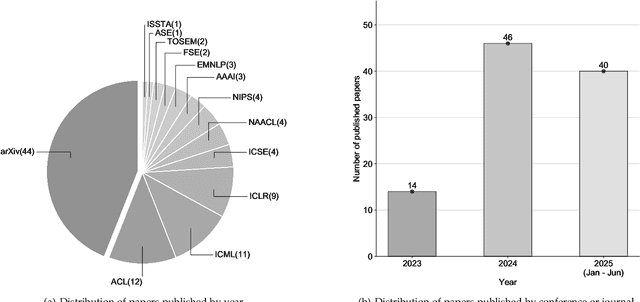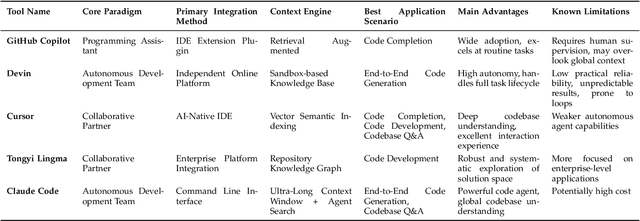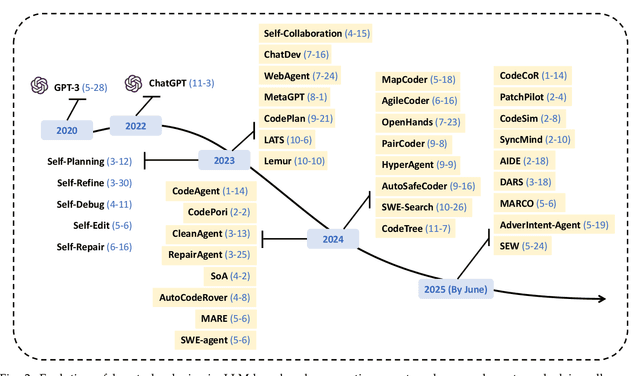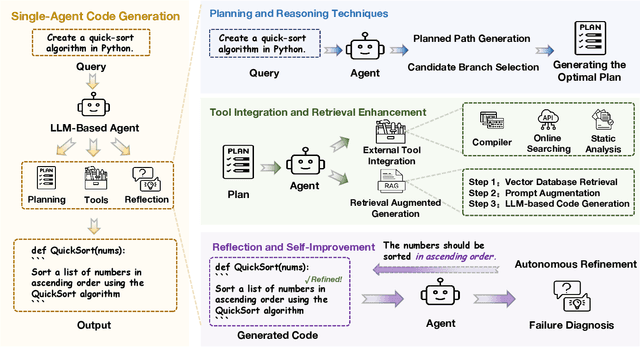Zhi Jin
GUI-ARP: Enhancing Grounding with Adaptive Region Perception for GUI Agents
Sep 19, 2025Abstract:Existing GUI grounding methods often struggle with fine-grained localization in high-resolution screenshots. To address this, we propose GUI-ARP, a novel framework that enables adaptive multi-stage inference. Equipped with the proposed Adaptive Region Perception (ARP) and Adaptive Stage Controlling (ASC), GUI-ARP dynamically exploits visual attention for cropping task-relevant regions and adapts its inference strategy, performing a single-stage inference for simple cases and a multi-stage analysis for more complex scenarios. This is achieved through a two-phase training pipeline that integrates supervised fine-tuning with reinforcement fine-tuning based on Group Relative Policy Optimization (GRPO). Extensive experiments demonstrate that the proposed GUI-ARP achieves state-of-the-art performance on challenging GUI grounding benchmarks, with a 7B model reaching 60.8% accuracy on ScreenSpot-Pro and 30.9% on UI-Vision benchmark. Notably, GUI-ARP-7B demonstrates strong competitiveness against open-source 72B models (UI-TARS-72B at 38.1%) and proprietary models.
Rethinking Testing for LLM Applications: Characteristics, Challenges, and a Lightweight Interaction Protocol
Aug 28, 2025Abstract:Applications of Large Language Models~(LLMs) have evolved from simple text generators into complex software systems that integrate retrieval augmentation, tool invocation, and multi-turn interactions. Their inherent non-determinism, dynamism, and context dependence pose fundamental challenges for quality assurance. This paper decomposes LLM applications into a three-layer architecture: \textbf{\textit{System Shell Layer}}, \textbf{\textit{Prompt Orchestration Layer}}, and \textbf{\textit{LLM Inference Core}}. We then assess the applicability of traditional software testing methods in each layer: directly applicable at the shell layer, requiring semantic reinterpretation at the orchestration layer, and necessitating paradigm shifts at the inference core. A comparative analysis of Testing AI methods from the software engineering community and safety analysis techniques from the AI community reveals structural disconnects in testing unit abstraction, evaluation metrics, and lifecycle management. We identify four fundamental differences that underlie 6 core challenges. To address these, we propose four types of collaborative strategies (\emph{Retain}, \emph{Translate}, \emph{Integrate}, and \emph{Runtime}) and explore a closed-loop, trustworthy quality assurance framework that combines pre-deployment validation with runtime monitoring. Based on these strategies, we offer practical guidance and a protocol proposal to support the standardization and tooling of LLM application testing. We propose a protocol \textbf{\textit{Agent Interaction Communication Language}} (AICL) that is used to communicate between AI agents. AICL has the test-oriented features and is easily integrated in the current agent framework.
RPD-Diff: Region-Adaptive Physics-Guided Diffusion Model for Visibility Enhancement under Dense and Non-Uniform Haze
Aug 23, 2025Abstract:Single-image dehazing under dense and non-uniform haze conditions remains challenging due to severe information degradation and spatial heterogeneity. Traditional diffusion-based dehazing methods struggle with insufficient generation conditioning and lack of adaptability to spatially varying haze distributions, which leads to suboptimal restoration. To address these limitations, we propose RPD-Diff, a Region-adaptive Physics-guided Dehazing Diffusion Model for robust visibility enhancement in complex haze scenarios. RPD-Diff introduces a Physics-guided Intermediate State Targeting (PIST) strategy, which leverages physical priors to reformulate the diffusion Markov chain by generation target transitions, mitigating the issue of insufficient conditioning in dense haze scenarios. Additionally, the Haze-Aware Denoising Timestep Predictor (HADTP) dynamically adjusts patch-specific denoising timesteps employing a transmission map cross-attention mechanism, adeptly managing non-uniform haze distributions. Extensive experiments across four real-world datasets demonstrate that RPD-Diff achieves state-of-the-art performance in challenging dense and non-uniform haze scenarios, delivering high-quality, haze-free images with superior detail clarity and color fidelity.
RL-PLUS: Countering Capability Boundary Collapse of LLMs in Reinforcement Learning with Hybrid-policy Optimization
Jul 31, 2025Abstract:Reinforcement Learning with Verifiable Reward (RLVR) has significantly advanced the complex reasoning abilities of Large Language Models (LLMs). However, it struggles to break through the inherent capability boundaries of the base LLM, due to its inherently on-policy strategy with LLM's immense action space and sparse reward. Further, RLVR can lead to the capability boundary collapse, narrowing the LLM's problem-solving scope. To address this problem, we propose RL-PLUS, a novel approach that synergizes internal exploitation (i.e., Thinking) with external data (i.e., Learning) to achieve stronger reasoning capabilities and surpass the boundaries of base models. RL-PLUS integrates two core components: Multiple Importance Sampling to address for distributional mismatch from external data, and an Exploration-Based Advantage Function to guide the model towards high-value, unexplored reasoning paths. We provide both theoretical analysis and extensive experiments to demonstrate the superiority and generalizability of our approach. The results show that RL-PLUS achieves state-of-the-art performance compared with existing RLVR methods on six math reasoning benchmarks and exhibits superior performance on six out-of-distribution reasoning tasks. It also achieves consistent and significant gains across diverse model families, with average relative improvements ranging from 21.1\% to 69.2\%. Moreover, Pass@k curves across multiple benchmarks indicate that RL-PLUS effectively resolves the capability boundary collapse problem.
A Survey on Code Generation with LLM-based Agents
Jul 31, 2025



Abstract:Code generation agents powered by large language models (LLMs) are revolutionizing the software development paradigm. Distinct from previous code generation techniques, code generation agents are characterized by three core features. 1) Autonomy: the ability to independently manage the entire workflow, from task decomposition to coding and debugging. 2) Expanded task scope: capabilities that extend beyond generating code snippets to encompass the full software development lifecycle (SDLC). 3) Enhancement of engineering practicality: a shift in research emphasis from algorithmic innovation toward practical engineering challenges, such as system reliability, process management, and tool integration. This domain has recently witnessed rapid development and an explosion in research, demonstrating significant application potential. This paper presents a systematic survey of the field of LLM-based code generation agents. We trace the technology's developmental trajectory from its inception and systematically categorize its core techniques, including both single-agent and multi-agent architectures. Furthermore, this survey details the applications of LLM-based agents across the full SDLC, summarizes mainstream evaluation benchmarks and metrics, and catalogs representative tools. Finally, by analyzing the primary challenges, we identify and propose several foundational, long-term research directions for the future work of the field.
Rethinking Regularization Methods for Knowledge Graph Completion
May 29, 2025



Abstract:Knowledge graph completion (KGC) has attracted considerable attention in recent years because it is critical to improving the quality of knowledge graphs. Researchers have continuously explored various models. However, most previous efforts have neglected to take advantage of regularization from a deeper perspective and therefore have not been used to their full potential. This paper rethinks the application of regularization methods in KGC. Through extensive empirical studies on various KGC models, we find that carefully designed regularization not only alleviates overfitting and reduces variance but also enables these models to break through the upper bounds of their original performance. Furthermore, we introduce a novel sparse-regularization method that embeds the concept of rank-based selective sparsity into the KGC regularizer. The core idea is to selectively penalize those components with significant features in the embedding vector, thus effectively ignoring many components that contribute little and may only represent noise. Various comparative experiments on multiple datasets and multiple models show that the SPR regularization method is better than other regularization methods and can enable the KGC model to further break through the performance margin.
Enhancing Transformation from Natural Language to Signal Temporal Logic Using LLMs with Diverse External Knowledge
May 27, 2025Abstract:Temporal Logic (TL), especially Signal Temporal Logic (STL), enables precise formal specification, making it widely used in cyber-physical systems such as autonomous driving and robotics. Automatically transforming NL into STL is an attractive approach to overcome the limitations of manual transformation, which is time-consuming and error-prone. However, due to the lack of datasets, automatic transformation currently faces significant challenges and has not been fully explored. In this paper, we propose an NL-STL dataset named STL-Diversity-Enhanced (STL-DivEn), which comprises 16,000 samples enriched with diverse patterns. To develop the dataset, we first manually create a small-scale seed set of NL-STL pairs. Next, representative examples are identified through clustering and used to guide large language models (LLMs) in generating additional NL-STL pairs. Finally, diversity and accuracy are ensured through rigorous rule-based filters and human validation. Furthermore, we introduce the Knowledge-Guided STL Transformation (KGST) framework, a novel approach for transforming natural language into STL, involving a generate-then-refine process based on external knowledge. Statistical analysis shows that the STL-DivEn dataset exhibits more diversity than the existing NL-STL dataset. Moreover, both metric-based and human evaluations indicate that our KGST approach outperforms baseline models in transformation accuracy on STL-DivEn and DeepSTL datasets.
Universal Biological Sequence Reranking for Improved De Novo Peptide Sequencing
May 23, 2025Abstract:De novo peptide sequencing is a critical task in proteomics. However, the performance of current deep learning-based methods is limited by the inherent complexity of mass spectrometry data and the heterogeneous distribution of noise signals, leading to data-specific biases. We present RankNovo, the first deep reranking framework that enhances de novo peptide sequencing by leveraging the complementary strengths of multiple sequencing models. RankNovo employs a list-wise reranking approach, modeling candidate peptides as multiple sequence alignments and utilizing axial attention to extract informative features across candidates. Additionally, we introduce two new metrics, PMD (Peptide Mass Deviation) and RMD (residual Mass Deviation), which offer delicate supervision by quantifying mass differences between peptides at both the sequence and residue levels. Extensive experiments demonstrate that RankNovo not only surpasses its base models used to generate training candidates for reranking pre-training, but also sets a new state-of-the-art benchmark. Moreover, RankNovo exhibits strong zero-shot generalization to unseen models whose generations were not exposed during training, highlighting its robustness and potential as a universal reranking framework for peptide sequencing. Our work presents a novel reranking strategy that fundamentally challenges existing single-model paradigms and advances the frontier of accurate de novo sequencing. Our source code is provided on GitHub.
Mutual Evidential Deep Learning for Medical Image Segmentation
May 18, 2025Abstract:Existing semi-supervised medical segmentation co-learning frameworks have realized that model performance can be diminished by the biases in model recognition caused by low-quality pseudo-labels. Due to the averaging nature of their pseudo-label integration strategy, they fail to explore the reliability of pseudo-labels from different sources. In this paper, we propose a mutual evidential deep learning (MEDL) framework that offers a potentially viable solution for pseudo-label generation in semi-supervised learning from two perspectives. First, we introduce networks with different architectures to generate complementary evidence for unlabeled samples and adopt an improved class-aware evidential fusion to guide the confident synthesis of evidential predictions sourced from diverse architectural networks. Second, utilizing the uncertainty in the fused evidence, we design an asymptotic Fisher information-based evidential learning strategy. This strategy enables the model to initially focus on unlabeled samples with more reliable pseudo-labels, gradually shifting attention to samples with lower-quality pseudo-labels while avoiding over-penalization of mislabeled classes in high data uncertainty samples. Additionally, for labeled data, we continue to adopt an uncertainty-driven asymptotic learning strategy, gradually guiding the model to focus on challenging voxels. Extensive experiments on five mainstream datasets have demonstrated that MEDL achieves state-of-the-art performance.
Rethinking Repetition Problems of LLMs in Code Generation
May 15, 2025Abstract:With the advent of neural language models, the performance of code generation has been significantly boosted. However, the problem of repetitions during the generation process continues to linger. Previous work has primarily focused on content repetition, which is merely a fraction of the broader repetition problem in code generation. A more prevalent and challenging problem is structural repetition. In structural repetition, the repeated code appears in various patterns but possesses a fixed structure, which can be inherently reflected in grammar. In this paper, we formally define structural repetition and propose an efficient decoding approach called RPG, which stands for Repetition Penalization based on Grammar, to alleviate the repetition problems in code generation for LLMs. Specifically, RPG first leverages grammar rules to identify repetition problems during code generation, and then strategically decays the likelihood of critical tokens that contribute to repetitions, thereby mitigating them in code generation. To facilitate this study, we construct a new dataset CodeRepetEval to comprehensively evaluate approaches for mitigating the repetition problems in code generation. Extensive experimental results demonstrate that RPG substantially outperforms the best-performing baselines on CodeRepetEval dataset as well as HumanEval and MBPP benchmarks, effectively reducing repetitions and enhancing the quality of generated code.
 Add to Chrome
Add to Chrome Add to Firefox
Add to Firefox Add to Edge
Add to Edge